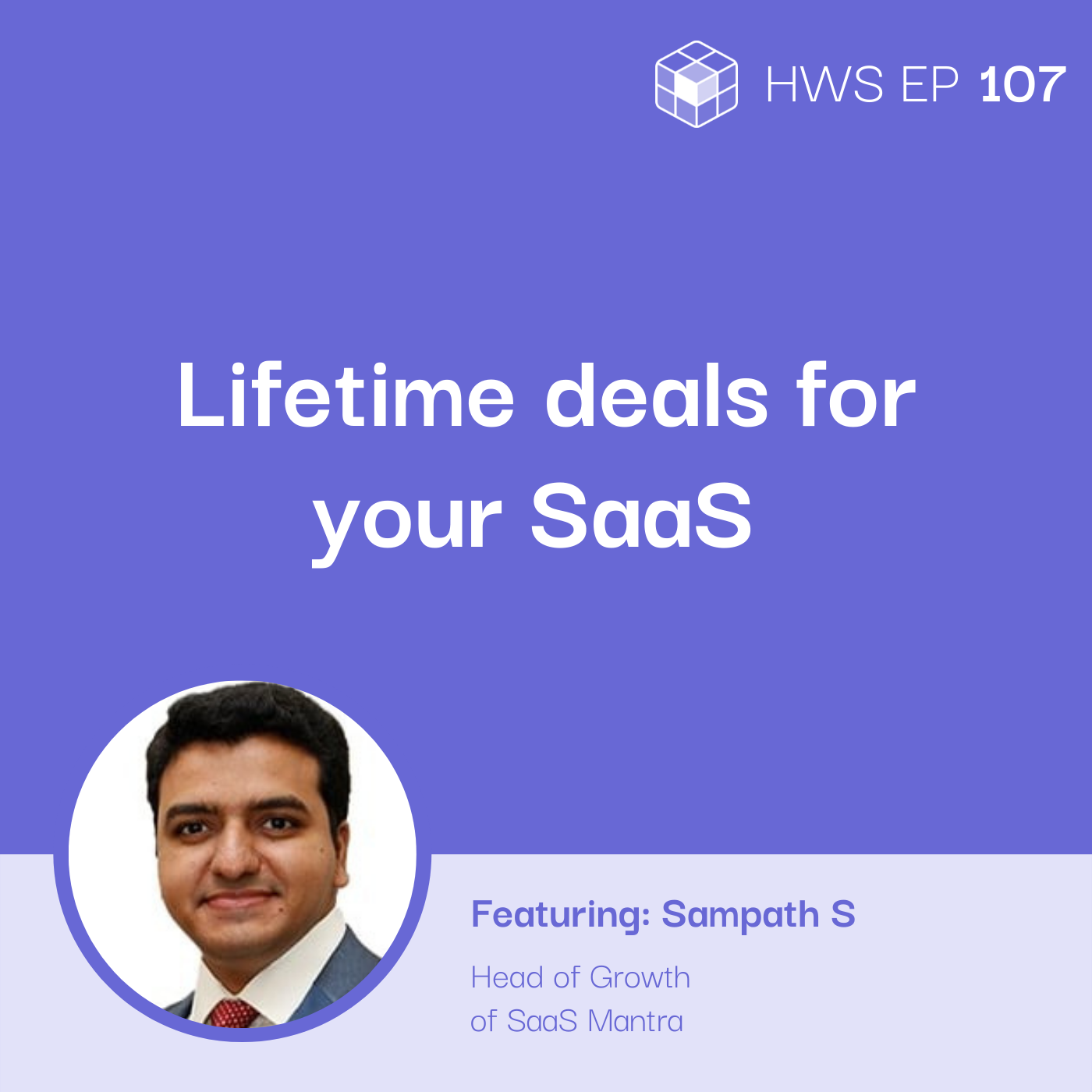Listen on:
Table of Contents:
Problem: When are lifetime deals a good idea for your SaaS product?
According to Statista, there is approximately 15,000 software as a service (SaaS) companies in the U.S. Collectively, they have around 14 billion customers worldwide. Sampath S, Head for Growth, SaaS Mantra, shares how early players have dominated the market since 2015-2016. New entrants, especially those that started in 2017, have to deal with stiff competition. One option that can be very effective is to market a low-priced lifetime deal for your SaaS product. But when is this a good idea? And how should they be implemented and marketed?
Your challenge here is to get those customers to start using your product. And you want them to migrate from what product they have been already using. That is the focus here and not trying to give something like a teaser, trying to bring them in and then trying to make money out of them. So, they’re going to feel like, “Okay, I have been played.” We don’t want customers to think of that at any given point in time.”
Customers for Life
Providing a free trial at the beta stage of your development could be useful. This strategy, however, has a significant drawback: most customers do not pay attention to free subscriptions, especially when they receive many freebies each week. In addition, you can only use so many tools at a time, which makes big discounts less relevant after a while. Sampath’s team at SaaS Mantra found the perfect way to get subscribers, feedback, and upgrade requests- offer lifetime deals. You can use this strategy to acquire subscribers early on and offer upgrades as you add more features. In addition, you can grow alongside your customers.
That’s when we came up with the idea for a lifetime deal where people have to pay some amount to get access to a product. Since they also got a huge bargain, they also want to see the product grow because that’s the specialty of SaaS when compared to the traditional software. When you have software, you have to keep on improvising month after month, week after week, year after year. Yes, I knew it was really good because people started paying for the product, which they believe will help solve the problem or help them to grow their business, etcetera.
Tip # 1: Allow Exploration, Especially for Key Features
SaaS is not about the product; it’s about solving the problems of the customer. Always prioritize giving your loyal members access to key features overgrowing your revenue from these new features. Provide them with enough time to explore the new additions and get their feedback on whether they would be willing to pay for them in the future. Find out how they intend to use the product going forward.
What would be more interesting is giving away the access to the key features of your product and letting the customers explore. Give them more room where they can play around with the product. Then see how they are going to actually use the products. Which means you don’t want to hold anything back and do something for the customers to start playing with.”
Tip # 2: Offer Limited Deals Designed for their Growth
Instead of focusing on giving them the whole menu of features they can add on, share the ones that can help their growth. For example, if your targets are solopreneurs, give them features that can accommodate any employees who will come in. Features that will allow their growing team to collaborate and work together.
This company is something that I want to stick with because I have more room so that I can bring in one of my partners as well. I can still use it at the same price when the business is actually growing. This is going to make the end-user think that you really cared for them, which is very important. And then they are happy to pay because with two people who are using the product, most likely they’re not going to switch especially if their pricing will be competitive after.
Tip # 3 Offer Upgrades Only When They’re Ready
Do not use new features to keep on upselling or encouraging upgrades. Recommend upgrades only when features are relevant and can solve the customer’s problem. Don’t forget, make sure these new features’ basic function works when the discount is offered. You don’t want them to feel shortchanged. In other words, be careful about how and when you offer your lifetime deals.
You can also offer discounts when they are ready to go for an upgrade. Like they can switch annually, but they have to start paying 30 or 40%. And we’ll discount if they are happy to pay annually and stop the monthly. So, something like that. You can monetize from the users, which will be helpful for you. Easy for you in two ways. One, they are very happy because they can start the business without having to worry about paying you monthly. And two, they’re also getting some extra room which is going to be, make them feel okay.”
Anticipate Challenges When Offering Lifetime Deals
Remember, once you start offering a lifetime deal for your SaaS, you need to anticipate growth. You have to think about challenges you might encounter in the future. Consider how you will:
- Respond to request for assistance, support, or troubleshooting
- Track the subscribers, their current packages, and how you can nurture them
- Address feedback and address issues about the product
- Be ready with clauses and rules for those who want to resell
- Behandling the amount of data and files you need to handle
The core of this is making sure you automate some parts of your processes and fine-tune your product. Give it a 40-60 day window before the launch. The extra time allows you to address the bugs and other technical problems before you roll out your promo.
So that is how the product should evolve. Working with so many different products, we bring that experience. And with that, you can start working on fine-tuning the products because our preparation begins at least 60 days in advance, anywhere between 40 and 60 days in advance.”
On not letting your customer do all the testing work
(00:07:35) There are products where it’s just like bad wounds initially, running left and for such a product at that stage is not ideal. Because when the user is starting to come, and they’re going to identify the low-key problems, which you could identify yourself when you run one or two tests—that’s not the ideal time to start learning a lesson. You must be happy to pay for your own product.
Sampath Encourages You to:
- Find lifetime deals at SaaS Mantra
- Or list your SaaS product to grow your user-base
This interview is part of the How We Solve podcast. To hear more from industry experts who are solving everyday business problems, check us out on Spotify, Apple Podcasts, and on our website.
About the guest

Sampath S
This episode features Sampath, a Growth Strategist, helping SaaS companies with User Acquisition, Product Validation & Accelerating Growth without spending a dime. He's working with SaaS startups to Corporates (since '07) that generate $5K to $500K revenue per month.
How people can people reach Sampath:
SaaS Mantra’s Official Website
LinkedIn: Sampath S
Twitter: @sampathspeaks
Listen on:
